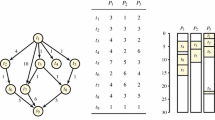Abstract
The Computational Grid (CG) provides a wide distributed platform for high end computing intensive applications. Scheduling on Computational grid is known to be NP-Hard problem and requires an efficient solution. Recently, quantum inspired computing has been introduced in the literature to solve such a complex combinatorial optimization problem efficiently. Combination of Genetic Algorithm (GA) and quantum concept evolves a new meta-heuristic technique known as Quantum Genetic Algorithms (QGA). QGA is a search procedure based on evolutionary computation and Quantum Computing (QC). This paper proposes a novel technique of scheduling in computational grid using QGA. The work simulates the model to study its performance. It also makes a comparative study with a GA-based scheduling model. Simulation results reveal the effectiveness of the model.






































Similar content being viewed by others
References
Abawajy JH (2005) Automatic job scheduling policy for grid computing. In: LNCS, vol 3516. Springer, Verlag, pp 101–104
Aggarwal M, Kent RD, Ngom A (2005) Genetic algorithm based schedulers for the computational grids. In: Proceedings of the 19th international symposium on high performance computing systems and applications (HPCS’05). IEEE Computer Society, Washington, pp 209–215
Berman F, Hey AJG, Fox GC (2003) Grid computing: making the global infrastructure a reality. Wiley, New York
Buyya R, Abramson D, Giddy J (2000) Nimrod/G: an architecture for resource management and scheduling system in a global computational grid. In: Proceedings of the high performance computing Asia, China, vol 1. IEEE CS Press, Washington, pp 283–289
Abraham A, Buyya R, Nath B (2000) Nature’s heuristics for scheduling jobs on computational grids. In: Proceedings of the 8th IEEE international conference on advanced computing and communications (ADCOM’00), India, pp 1–8
Chang RS, Chang JS, Lin PS (2009) An ant algorithm for balanced job scheduling in grids. Future Gener Comput Syst 25:20–27
Chen CK, Yu KM (2008) An evaluation based dynamic scheduling algorithm in grid computing environment. In: Proceedings of the 8th international conference on intelligent systems design and applications (ISDA’08). IEEE Computer Society, Washington, pp 450–455
Chen WN, Zhang J (2009) An ant colony optimization approach to grid work flow scheduling problem with various QoS requirements. IEEE Trans Syst Man Cybern, Part C, Appl Rev 39(1):29–43
Cooper RB (1977) Introduction to queuing theory. Macmillan, New York
Foster I, Kesselman C (2004) Grid 2: blueprint for a new computing infrastructure. Morgan Kaufmann, San Francisco
Gao Y, Rong H, Huang JZ (2005) Adaptive grid job scheduling with genetic algorithms. Future Gener Comput Syst 21(1):151–161
Grama A, Gupta A, Karypis G, Kumar V (2003) Introduction to parallel computing. Addison Wesley, Boston
Garey MR, Johnson DS (1979) Computers and intractability: a guide to the theory of NP-completeness. Freeman, New York
Goldenberg DE (2005) Genetic algorithms in search optimization and machine learning. Pearson Education, New Delhi, pp 215–290
Gu J, Gu X, Gu M (2009) A novel parallel quantum genetic algorithm for stochastic job shop scheduling. J Math Anal Appl 355:63–81
Han KH, Kim JH (2002) Quantum-inspired evolutionary algorithm for a class of combinatorial optimization. IEEE Trans Evol Comput 6(6):580–593
Han KH, Kim JH (2004) A quantum inspired evolutionary algorithm with a new termination criterion, H ε gate and two phase scheme. IEEE Trans Evol Comput 8(2):156–169
Li CP, Song PK, Shang HF (2011) Double chains quantum genetic algorithm with application to neuro-fuzzy controller design. Adv Eng Softw 42(10):875–886
Martino VD, Mililotti M (2004) Sub optimal scheduling in a grid using genetic algorithms. Parallel Comput 30:553–565
Mitchell M (2005) An introduction to genetic algorithms. Pearson Education, New Delhi
Niu Q, Zhou F, Zhou T (2010) Quantum genetic algorithm for hybrid flow shop scheduling problem to minimize total completion time. In: LNCS, vol 6329. Springer, Berlin, pp 21–29. Part (II)
Mingscheng Y (2010) In: Quantum computation, quantum theory and AI, Artificial intelligence, vol 174, pp 162–176
Parhami B (2002) Introduction to parallel processing: algorithms and architectures. Plenum, New York
Prakash S, Vidyarthi DP (2012) Observations on effect of IPC in GA based scheduling on computational grid. Int J Grid High Perform Comput 4(1):66–79
Quinn MJ (2005) Parallel computing: theory and practices. PHI Learning, New Delhi
Raza Z, Vidyarthi DP (2009) A computational grid scheduling model to minimize turnaround time using modified GA. Int J Artif Intell 3(A49):86–106
Raza Z, Vidyarthi DP (2009) GA based scheduling model for computational grid to minimize turnaround time. Int J Grid High Perform Comput 1(4):70–90
Silberschatz A, Galvin PB, Gagne G (2004) Operating systems concepts. Wiley, New Delhi
Sinnen O, Sousa LA (2005) Communication contention in task scheduling. IEEE Trans Parallel Distrib Syst 16(6):503–515
Tanenbaum AS (2002) Modern operating systems. PHI Learning, New Delhi
Tanenbaum AS (2002) Distributed operating system. Pearson Education, New Delhi
Tiwari PK, Vidyarthi DP (2011) A variant of quantum genetic algorithm and its possible applications. In: Proceedings of the Springer, Advances in intelligent and soft computing, vol 130, pp 797–811
Tripathi AK, Sarker BK, Kumar N, Vidyarthi DP (2000) A GA based multiple task considering load. Int J High Speed Comput 11(4):203–214
Vidyarthi DP, Sarker BK, Tripathi AK, Yang LT (2009) Scheduling in distributed computing systems: analysis, design, and models. Springer, Berlin
Xhafa F, Carretero J, Abraham A (2007) Genetic algorithm based schedulers for grid computing systems. Int J Innov Comput Inf Control 3(6):1–19
Xhafa F, Abraham A (2008) Meta-heuristics for grid scheduling problems. In: Studies in computational intelligence series, vol 146. Springer, Berlin, pp 1–37
Author information
Authors and Affiliations
Corresponding author
Rights and permissions
About this article
Cite this article
Prakash, S., Vidyarthi, D.P. A novel scheduling model for computational grid using quantum genetic algorithm. J Supercomput 65, 742–770 (2013). https://doi.org/10.1007/s11227-012-0864-9
Published:
Issue Date:
DOI: https://doi.org/10.1007/s11227-012-0864-9




